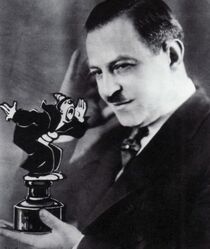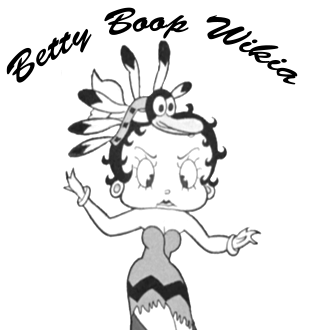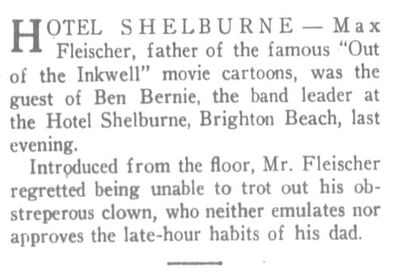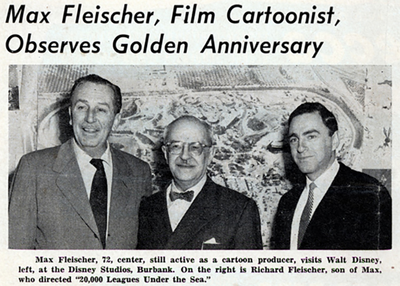| Max Fleischer | |
|---|---|
 | |
|
Name |
Max Fleischer |
Max Fleischer was an American animator. He was a pioneer in the development of the animated cartoon and served as the head of Fleischer Studios. He brought such animated characters as Betty Boop, Koko the Clown, Popeye and Superman to the movie screen and was responsible for a number of technological innovations.
Quotes
- Max Fleischer: "Betty Boop, is purely a creature of my own imagination."
- Max Fleischer: "My little screen clown has grown to be as famous in Cape Town and Shanghai as he is in the five and ten-cent picture houses from Harlem to where the pavement ends in Gopher Praire."
- Max Fleischer: "Gilbert Evans was the greatest newspaper man I've ever known and he could recognize genius when he saw it. Evans used to tell me that I had the makings of a great cartoonist, I took him at his word an so, you see, I've been striving for greatness ever since."
- Max Fleischer: "During the span of years from 1914, I have made efforts to retain the cartoony effect. That is, I did not welcome the trend of the industry to go arty. It was, and still is, my opinion that a cartoon should represent, in simple form, the cartoonist's mental expression."
- Max Fleischer: "No work is ever too tedious."
- Max Fleischer: "In other words the animated oil painting has taken the place of the flashiness and delightfulness of the simple cartoon. In my opinion, the industry must pull back."
- Max Fleischer: "It was after I had made a fairly sizeable start as an artist on The Eagle that I went to the Popular Science Magazine as a special writer and illustrator. There I first began the study of possibilities of the animated cartoon on the screen."
- Max Fleischer: "Pull away from the tendencies toward realism. It must stay in its own backyard of the cartoonist's cartoon. The cartoon must be a portrayal of the expression of the true cartoonist, in simple,unhampered cartoon style. The true cartoon is a great art in its own right. It does not need the assitance or support of artiness In fact, it is actually hampered by it."
Creation of Betty Boop
In August 1930, a Rubenesque poodle-human hybrid, Bimbo's girlfriend, made her screen debut in Dizzy Dishes, and quickly became Fleischer's biggest star; she would later be named Betty Boop. By 1931, Betty's floppy canine ears had evolved into hoop earrings, and she was transformed into a fully human girl (though she retained her romantic relationship with the dog for several episodes after her transmogrification). By the time of Minnie the Moocher (1932), Betty was in a class of her own, and by August 1932, starting with Stopping the Show, the Talkartoon series was renamed as Betty Boop Cartoons; by then, as noted by even the opening song from Stopping the Show, Betty clearly became the self-proclaimed "Queen of the Animated Screen." Along with his standout female star, Fleischer had become one of the two premier animation producers; the up-and-coming Walt Disney was the other.
Hotel Shelburne (1924)
Max Fleischer, father of the famous "Out of the Inkwell" movie cartoons, was the guest of Ben Bernie, the band leader at the Hotel Shelburne, Brighton Beach, last evening. Introduced from the floor, Mr. Fleischer regretted being unable to trot out of his obstreperous clown, who neither emulates nor approvesthe late-hour habits of his dad.
Max Fleischer Charges Employees With Piracy (1925)
In 1925, Max Fleischer brought suit asking a restraining injunction against four former employees, Burton Gillette, Emanuel Goldman, Benhamin Harrison and Edith Vernick, who he alleged had stolen ideas which he invented and had used them for commercial purposes. Max alleged that two of the processes used in the Out of the Inkwell series had been used by the quartet. These are what he calls the "cut-out system" and the "reverse color and action system". Although animated sketches are used by a number of cartoonists in motion pictures, Fleischer uses one which was unique, a method that he wanted to protect. In the complaint Fleischer alleged that he was the president of the Out of the Inkwell Company Inc., and that he employed the four defenndants to work in his plant, imparting to them the method of drawing the cartoons and training them in its use. Shortly afterwards, he alleged the four left him and organized for themselves the A.A. Studios, Inc., for the purpose of operating them with the same processes as those used by Fleischer, making use of the knowledge they gained while with him.
In the East (1932)
Max Fleischer to make 18 Screen Songs shorts for Paramount release next season in edition to 18 Betty Boop shorts.
Helen Kane Loses $25,000 Suit For Civil Violation (1934)
Helen Kane, the "Boop-Boop-a-Doop" girl today lost her suit for $25,000 against Max Fleischer, cartoonist, the Fleischer Studios, Inc., and the Paramount-Publix Corp. Supreme Court Justice Edward J. McGoldrich held that she had failed to prove her contention that the defendants wrongfully appropriated her singing technique in the "Betty Boop" film cartoons. Miss Kane said she was deeply shocked at the verdict. "I consider it very unfair as all my friends believe the cartoons a deliberate caricature of me." she said. Samuel R. Weltz, her attorney said an immediate appeal would be filed. The "Boop-Boop-a-Doop" trial began April 17, Miss Kane seeking damages on grounds that the defendants had used her picture in violation of the civil rights law and that the cartoons constituted "unfair competition."
Helen Kane Loses Plea (1936)
Appellate division rules against actress in $250,000 suit. Helen Kane of Boop-Boop-a-Doop fame from a decision of Supreme Court Justice Edward J. McGoldrick, dismissing her $250,000 injunction against the Paramount-Publix Corporation to restrain it from using her style of singing in animated cartoons, was dismissed unanimously today by tge appellate division. The court handed down no opinion with its decision. Miss Kane's action also was brought against Max Fleischer, cartoonist.
Max Fleischer Explains Sympathetic Interest In Art Classes (1938)
Production starts at the Max Fleischer Miami motion picture studios in September, an earlier date than originally anticipated. The first group of engineers and technical men will arrive from New York this week. Also there will arrive during the week sound-making equipment. And you members of the art class who have been going around with your hearts in your mouth wondering if the dream can com true are assured that it can. That a not saying it will for all of you, but artists who qualify will "be paid from $18 a week to $250 a week and that comes direct from Max Fleischer to Abe Aronovitz. Miami representative of the Fleischer, organization. "Just so there couldn't be any misunderstanding or false hope in connection with the class of about 90 paying tuition to learn the technique of animated cartoon work. I wrote a personal letter to Max Fleischer and his reply was a re quest to Mr. Aronovitz to "clear it up from all angles." In keeping with Mr. Fleischer's determination to merit the good will of the community in which he will live and operate his studios," said Mr. Aronovitz,. "he wishes to I make it plain that so far as possible residents of the Miami area will be given preference, and this of course applies to artists. The Fleischer organization has no con tract with the Miami Art school, nor official connection of any kind and does not guarantee members of the class employment. Mr. Fleischer does indicate sympathetic interest and whenever possible competent artists who have been properly trained will be given employment. Such assistance and suggestions as properly can be given is being supplied the class." And that's that. Construction of the studios at N. W. 30th ave. and 17th st. is reported more than five-sevenths completed. John H. Ware, president of the Delaware Housing Ass'n, Inc, is the contractor, Mr. Aronovitz further explained: "It is estimated that the studios will have a payroll in Miami of 350 persons. The studios plan their first production activity here in the latter part of September, transition from New York being scheduled for that time. The Max Fleischer Studios, Inc. is under contract to make three pictures a month. Therefore, it is necessary to begin partial production in the new studios, getting into full production as soon as possible. "The first major production, outside the regular Popeye, Betty Boop, Bouncing Ball, etc., program output, will be a $1,600,000 colored production for Paramount." Gulliver's Travels is understood to be the picture to be made. It will require 18 months to make and will be in color. Max Fleischer is in charge of production and distribution and Dave Fleischer is at the head of the story department where themes, gags and continuity are developed. Included in the equipment arriving this week will be the $100,000 "sound truck," only it isn't a truck at all. It is the highly technical device used for recording sound and is mobile. Originally, it had been intended to vocalize the "pictures in New York. Enlarged plans eliminated that procedure and all pictures will be completed in Miami and the studios in New York closed. Incidental to construction of the studios, which will have two and a half acres of floor space, is construction of nearby homes for employees. (The Miami News)
Max Fleischer Upset an Inkwell on the Rug 20 Years Ago (1939)
And out poured a host of movie stars: Betty Boop, Popeye and, now, the famous globe-trotting Gulliver by Frederick James Smith For his first feature-length color movie. Max picked the classic Gulliver's Travels. Popeye will "fight for peace, go to jail to uphold the law" hidden under the piano. Mrs. Fleischer discovered it eventually, but, anyway, it gave the boys a name for their movie: "Out of the Inkwell." The Fleischer boys kept their jobs, but they also kept working in the parlor at night, perfecting speedy methods of animating drawings. The World War interfered for a time. But even while he was in the Army at Fort Sill, Oklahoma. Max worked out a cartoon that showed recruits what happened when they pulled the trigger of their rifles. It was most effective when run off in slow motion. After the Armistice the brothers went to work in earnest. Fleischer produced two feature-length animated-drawing films some years before Walt Disney's Snow White. One, called Relativity, explained the Einstein theory by way of drawings. The other, based on Darwin's theory of evolution, was made at the time of the William Jennings Bryan-Clarence Darrow battle in the famous Scopes trial in Tennessee. Fleischer's greatest success, however, has been by way of short comedies. Successful cartoon characters frequently are accidents. A minor figure steals the picture, much as a bit player often walks off with a screen drama. That is how Donald Duck emerged from a Mickey Mouse background. Betty Boop was just such an accident. She appeared as an incidental figure in the background of a cartoon cabaret scene, and stole the show. That was in the Boop-a-Doop era, and the public demanded more of Betty. She became a star, and lasted as long as the Boop-a-Doop era. Fleischer became interested in Popeye because one of the elevator boys at the New York hotel where he lived waited each night for a comic sheet presenting the spinach people. And it all started in a Brooklyn apartment. That was twenty-two years ago. Two or three years before that Winsor McCay had made the first animated cartoon ever created, presenting Gertie the Dinosaur. McCay used it as part of a vaudeville act and aroused a lot of skeptical laughter when he predicted that animated cartoons would someday take their place with human films in the movie houses of the country. It was Gertie who inspired Max Fleischer to follow his ink-and-celluloid career. Born in Austria, Max had been brought to this country at the age of four. He had studied art at the Art Students League and mechanics at the Mechanics and Tradesmen High School in New York, while working as copy boy at two dollars a week on "The Brooklyn Eagle". He had advanced quickly to the art department of the "Eagle," and moved on to the post of cartoonist. In the same department was J. R. Bray, another pioneer in making cartoon films. The two talked over their ideas, worked together nights trying to perfect them. Finally, after a year, a 150-foot cartoon comedy was turned out. Fleischer took it around to a movie distributor, who looked it over with interest. "I'll buy one a week," he announced. Sadly, Max told him how long it had taken to make the 150-footer. The distributor lost interest. But Fleischer went back to work and devised a way to produce a hundred feet every fourth week. Two of his brothers, Dave, then a photo-engraver, and Joe, a mechanic, were his helpers, and their workroom was the parlor of the six-room apartment in Brooklyn where Max and his wife lived. One night the boys spilled a bottle of ink on the rug. Mrs. Fleischer had gone to bed, so the movie-makers quietly shifted the rug around until the ink-spot was Max Fleischer is the unknown man of the movies. Out of an inkwell he manufactures fantasy turns out an exact amount of that elusive thing of dreams each week. And he is as fantastic as anything he creates. Fleischer was one of the first men to make drawings move, to give life to pen-and-ink characters. For twenty-two years he has been amusing the public with animated cartoons. Today he is head of a SI, 250,000 motion-picture studio, a colossus of cartoons. Yet when he steps outside of the studio that fantasy built he is just a gray-haired little man of five feet, five, whom nobody knows. It was Fleischer who produced the Out of the Inkwell comedies and Koko the Clown. It was Fleischer who did Betty Boop and Popeye, who produced those animated lures to mass-audience singing the melodies with the bouncing ball. And it is Fleischer who has made the newest feature-length picture of ink, color and celluloid, Gulliver's Travels. By all contemporary standards he is entitled to a whole corps of yes men to follow him around his studio but he goes alone. Nobody opens doors for him. His employees just say hello and Max nods politely. Fleischer's pictures have made many box-office millions. But he always does his personal shopping on the installment plan says he can't save money, even though he never bets on the horses. He spends it all working out eccentric ideas, such as a mechanical ash tray or a trick inkwelL And any scheme to improve cartoon comedies interests him vitally. Fleischer has twenty-eight patents for cartoon devices. He heads one of the two -biggest animated-cartoon "plants" in the world. The other belongs to Walt Disney. Fleischer's studio occupies a complete city square . in Miami, Florida, and employs 650 specialist. Fleischer says he came to like Popeye because "he'd fight for peace, go to jail to uphold the law." The Fleischer plant now turns out thirty-eight one and two-reel animated comedies a year. Besides Popeye, there is the Hunky and Spunky series about two mules. And for the last year and a half they have been working on Gulliver on the side. Fleischer likes to explain why he made Gulliver's Travels. "Every adult is still a child at heart," he says. "They are sorry they have been told there is no Santa Claus and they would like to say, "You're wrong, there is a Santa Claus and there are elves and witches and fairies. People want to believe in fantasy because it is an escape from the hard realism of the world." When Fleischer started work on Gulliver's Travels some 7.000 sketches were prepared. Before the studio got through over a million drawings had been made, of which some 200.000 show in the final print. When Fleischer moved his studio to Florida from New York last October, two hundred specialists in the making of cartoon comedies went with him. Some had been twenty years in his employ, at least twenty-five had been with him twelve years, and forty for better than seven years. There are eighty animators alone, besides specialists who supply the voices and music, inkers, colorists. technicians, mechanics, cameramen and minor workers. A five-day week is the rule, with a minimum pay of eighteen dollars for beginners. (The Baltimore Sun)
Max Fleischer and Walt Disney (1956)
On the 4th of January 1956, the Fleischer Studios once rival studio The Walt Disney Company founder Walter Elias Disney met Max Fleischer. The meeting was set up by Richard Fleischer, who had directed 20,000 Leagues Under the Sea. Fleischer, 72 at the time creator of Out of the Inkwell, Popeye and Betty Boop cartoons, spent Monday at the Disney studio. Max Fleischer a veteran cartoonist was still active and was working on secret training films for the U.S Navy. He came to the coast to celebrate his golden wedding anniversary with Mrs. Essie Fleischer. Max stayed in Beverly Hills with his son, Richard, who was a director including the latter's wife and three children. Fleischer started as a newspaper cartoonist with the Brooklyn Eagle nearly half a century ago. He is one of the real pioneers of animated cartoons still active. He made training films as far back as World War I. Among Fleischer's scientific creations were his cartoon productions of "Einstein's Theory of Relativity" and "Darwin's Theory of Evolution." His son Richard, directed 20,000 Leagues Under the Sea, for Disney.
Death
Max Fleischer died from heart failure on September 11, 1972, after a period of poor health. On the day of his death, Fleischer was cited as a great pioneer who invented an industry, and was named by Time Magazine as the "Dean of Animated Cartoons".
Trivia
- His son Richard Fleischer was hired by Walt Disney, who was Max's main competitor, to direct the Disney blockbuster "20000 Leagues Under the Sea".
- In 1944, Max released a book entitled Noah's Shoes, a book which humorously covers the whole animal kingdom.
- Although Disney and Max Fleischer had been competitors for decades by that time, they had never actually met, and in fact Richard said that Disney often asked him, "How's your dad doing?".
- According to Max Fleischer's book "Noah's Shoes" (1944), he held fifteen patents then being used in the motion picture industry. Fleischer produced some of the first war training films for the U.S. Army. Max Fleischer and his brother Dave Fleischer both released and produced the first sound cartoons.
- The first released was Come Take a Trip in My Airship. The first produced was My Old Kentucky Home. Co-founded, with Dave Fleischer, animation production company Inkwell Studios in 1927.
- Awarded U.S. patent 1,242,674 ("Method of Producing Moving Picture Cartoons") for the rotoscope, which allowed film footage of a live figure to be used as a guide for drawing.
- Father to Ruth Fleischer and Richard Fleischer.
- After actress Helen Kane tried to sue the studios for allegedly stealing her style, Max couldn't stand the actress and had her blacklisted from a newspaper and could he could not bring himself to say another good word about her.



